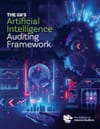📘 What’s Covered
The IIA’s Artificial Intelligence Auditing Framework is a structured, practical guide for internal auditors tasked with providing assurance and advisory support in AI-augmented environments. Updated to reflect the exponential growth in enterprise AI adoption—especially following the rise of generative AI—the framework balances strategic oversight with practical checklists.
The document is divided into four parts:
- OverviewCovers AI’s evolution, from Alan Turing’s early ideas to today’s LLMs like ChatGPT and Bard. It breaks down AI types (Reactive, Limited Memory, Theory of Mind, Self-Aware) and use cases such as virtual assistants, generative tools, and expert systems. Adoption stats from IBM, McKinsey, and EY frame the urgency for AI assurance.
- Getting StartedHelps auditors assess whether AI is used in the organization, and how. It emphasizes mapping AI use across departments, identifying responsible teams, and collaborating with leadership. Practical guidance includes reviewing policies, inventorying AI tools, and analyzing board-level strategy alignment.
- AI Auditing FrameworkOrganized around The IIA’s Three Lines Model—Governance, Management, and Internal Audit—it details strategic alignment, ethical risks, data governance, technical resourcing, third-party controls, and ongoing monitoring. It emphasizes the importance of risk appetite alignment, privacy, transparency, and bias mitigation.
- Practitioner’s Guide & GlossaryOffers a checklist of audit-ready criteria, spanning AI strategy, data governance, cyber risks, organizational training, vendor controls, and reporting. A detailed glossary anchors key terms and frameworks (e.g., NIST RMF, COSO, COBIT).
The framework is deeply aligned with existing audit practices and standards but expands them to meet the evolving demands of AI deployments. It addresses both the “how” (controls, data, governance) and the “why” (alignment with mission, transparency, ethical safeguards) of auditing AI systems.
💡 Why it matters?
This is one of the few AI audit guides grounded in mainstream audit practices and written for real-world enterprise adoption. While many AI ethics tools focus on design, this framework tackles the operational accountability of deployed systems—something most organizations urgently need. It’s especially helpful for aligning internal audit with enterprise risk management (ERM), AI governance, and compliance teams, without requiring auditors to be AI experts.
⚠️ What’s Missing
The framework assumes a relatively mature governance environment. It doesn’t directly address cross-border compliance (like EU AI Act or China’s AI regulation) or detail technical evaluation of specific AI model risks (e.g., adversarial testing, robustness validation). While it nods to the NIST AI RMF, it doesn’t offer in-depth integration guidance. For highly technical AI systems, especially those involving continuous learning or dynamic environments, additional tooling or external expertise will likely be necessary.
✅ Best For
- Internal auditors tasked with reviewing AI use in mid-to-large organizations
- Governance or risk professionals building AI assurance functions
- Audit committees and boards seeking oversight practices
- Enterprises aligning their internal controls with AI deployments
🧾 Source Details
- Title: The IIA’s Artificial Intelligence Auditing Framework
- Publisher: The Institute of Internal Auditors
- Date: 2024
- Authors: George Barham et al.
- Standard references: IIA IPPF, COSO, COBIT, NIST AI RMF
- Length: 32 pages
- Link (if public): theiia.org (no direct link available)


